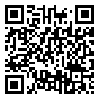BibTeX | RIS | EndNote | Medlars | ProCite | Reference Manager | RefWorks
Send citation to:
URL: http://ismj.bpums.ac.ir/article-1-592-en.html
2- Department of Biology, Belarusian State University, Nezavisimosti , 220030 Minsk, Belarus
3- Tuberculosis and Pediatric Infectious Research Center and Department of Microbiology, Arak University of Medical Sciences, Arak, IRAN ,
Background: Quarterly Ammonium Compounds (QuAC) are the more effective antimicrobial agents in medicine and industry. It needs to produce the new compounds with the wider spectrum and less toxicity, because of microbial resistance. Aim of this study was microbiological Evaluation of the new Quarterly Ammonium Compounds produced by Structural modifications on some bacteria, yeast and fungi. Material and Methods: 16 Quat salts were designed and made in Ethanol or Aceto Nitril. Minimum Inhibitory Concentration (MIC) was determined by standard method on Nutrient Broth and Minimal agar culture media for bacteria , Potato Dextrose Agar (PDA) for fungi and Nutrient Agar and Saboro Dextrose Agar (SDA) for yeasts . Results: Compounds 2,7,8,9,12,13 has the more antimicrobial effect ( minimum of MIC). Furthermore, it was shown that MIC was unrelated to culture compounds. In yeast culture it must to increases the concentration in enriched media. Compounds 9,12 and 13 has the more antibacterial effect as well as antifungal effect. Conclusion: In comparison of structure of produced compounds and results of the study, it was revealed that radical R3 has the most important role in antimicrobial properties of Quats and it could to be substitute any suitable group related to increasing anti microbial effects.
Received: 2012/11/16 | Accepted: 2013/01/31 | Published: 2014/08/12
| Rights and Permissions | |
 |
This work is licensed under a Creative Commons Attribution-NonCommercial 4.0 International License. |





